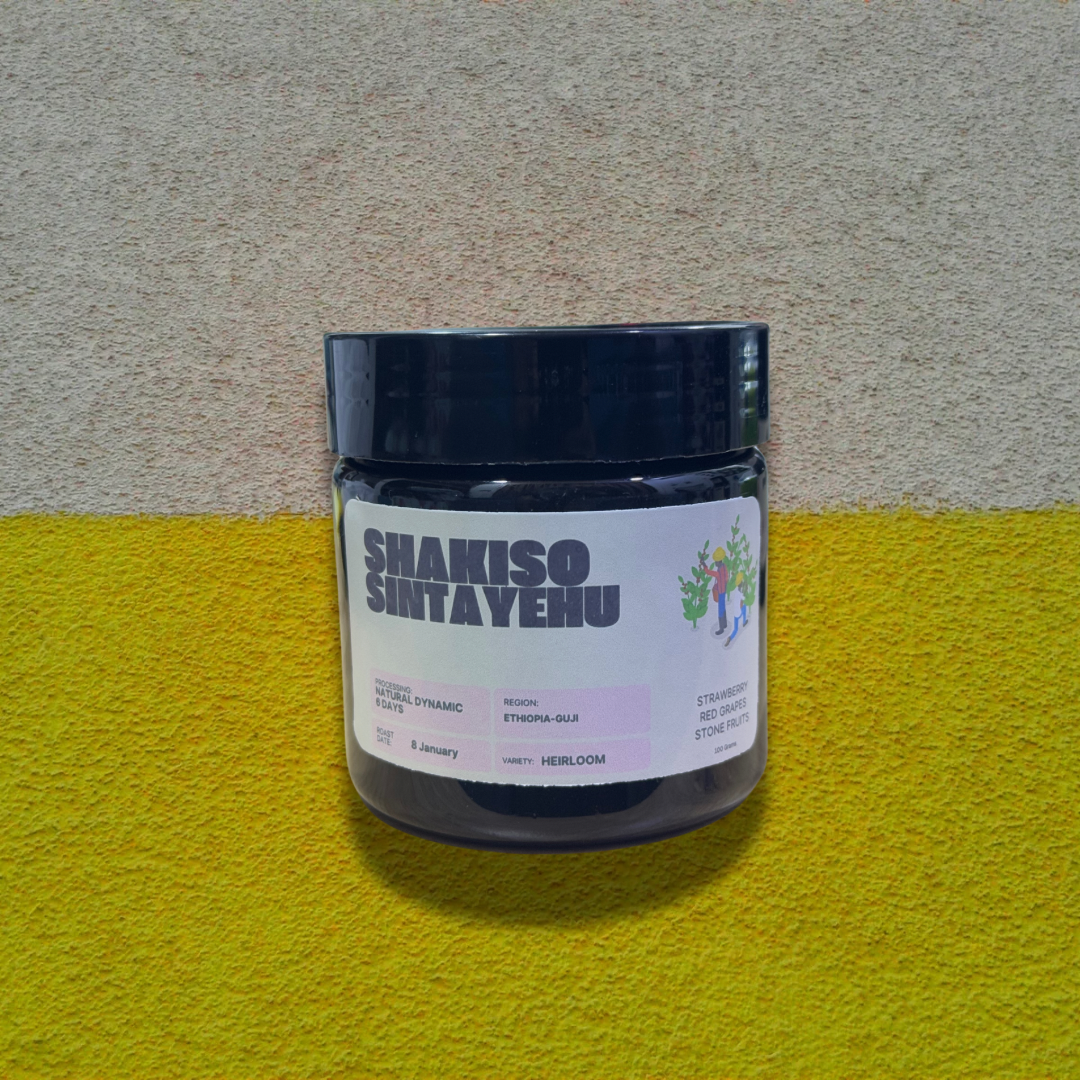RABBIT TWINS
SHAKISO SINTAYEHU_ETHIOPIA
SHAKISO SINTAYEHU_ETHIOPIA
Couldn't load pickup availability
- Variety: HEIRLOOM
- Country: ETHIOPIA
- Region: GUJI
- Process: NATURAL DYNAMIC 6 DAYS
- Altitude:1,900 - 2,200 MASL
- Roast Level: Medium Light
-
TASTING NOTES : STRAWBERRY,RED GRAPES , STONE FRUITS
السلالة: ايرلوم
البلد: إثيوبيا
المنطقة: قوجي
المعالجة: مجففة وديناميكية لمدة 6 أيام
الارتفاع: 1,900 - 2,200 متر فوق سطح البحر
مستوى التحميص: متوسط فاتح
ملاحظات التذوق: الفراولة، العنب الأحمر، الفواكه ذات النواة
About The Farm:
Sintayehu Admasu was born in Guji Uraga and grew up there. He always wanted to be a farmer but because he went to school was influenced to go into law.
After many years practicing law in Addis Ababa he went back to. Guji Shakiso area to start a small coffee farm. Although it was difficult at 1st he later became successful and grew his farm to an area of over 120 Hectares.
Now it has been more than 20 years since his beginning, and now he owns and operates not only a farm but a processing and pulping mill and even processing coffees for other farmers who don't have
the capacity.
وُلد سينتايهو أدماسو في منطقة غوجي أوراجا ونشأ هناك. كان دائماً يرغب في أن يصبح مزارعاً، ولكن بسبب التحاقه بالمدرسة تأثر بدخول مجال القانون.
بعد سنوات عديدة من ممارسة القانون في أديس أبابا، عاد إلى منطقة غوجي شاكيسو ليبدأ مزرعة قهوة صغيرة. وعلى الرغم من صعوبة البدايات، تمكن لاحقًا من تحقيق النجاح وتوسيع مزرعته لتصل مساحتها إلى أكثر من 120 هكتارًا.
الآن، بعد أكثر من 20 عامًا منذ البداية، يمتلك ويُدير سينتايهو أدماسو ليس فقط مزرعة، بل أيضًا مطحنة لمعالجة وتنقية القهوة، بل ويعالج قهوة مزارعين آخرين ليس لديهم القدرة على القيام بذلك.
Processing
Dynamic process
*First Stage: Picking and Sorting*
Ripened coffee beans are picked and taken to raised drying beds where they are sorted by hand to remove green and overripe cherries.
*Second Stage: Fermentation*
Once sorting is done, cherries are left on the beds for 2 days or 48 hours by which time, the beans have started partial fermentation and lose some of their moisture. After 48 hours, the beans are put in food-grade plastic bags for their second round of Anaerobic fermentation. the bags are then sealed with zip-tie and stored in a warm dry place away from direct sunlight. This storage process could take from 3 to 12 days depending on the level of fermentation required to develop varying types, intensities of aroma and flavor.
*Third Stage: Drying*
This step involves taking the cherries out of the food -grade bags and spreading them across the drying beds where they will be allowed to slow-dry in a process that could take somewhere between 14 and 21 days. Constant follow up is also conducted to ensure uniform and consistent drying in every batch.
*Fourth Stage: Resting and Storing*
Once the beans have dried, they are collected from the beds and stored in jute bags to make sure they rest and develop more flavor. The resting stage can be anywhere from 2 to 4 months.
*Fifth Stage: Pulping and Processing*
Once rested, the beans are examined for level of dryness in order to proceed to hulling. Cherry covers need to be dry and brittle enough for hulling machines to effectively shed the cover and the inner parchment without damaging the inner bean. Therefore; depending on temperature, 1 or 2 days of further drying could be necessary to achieve this level of brittleness. Once the cherries have been pulped and the inner parchment removed, the fresh beans are sealed in food -grade plastic bags to retain their fresh flavor and transported to a cleaning and packaging facility in Addis Ababa.
*Sixth Stage: Final Processing*
As soon as the beans arrive in the processing facility in Addis Ababa, they undergo another stage of cleaning to reduce impurities such as broken, oversized, black or immature beans or any remaining foreign matter such as parchment bits. After this they are packaged in food -grade plastic bags and jute bags and shipped to the international market.
عملية ديناميكية
المرحلة الأولى: القطف والفرز
يتم قطف حبوب القهوة الناضجة ونقلها إلى أسِرّة تجفيف مرتفعة، حيث يتم فرزها يدويًا لإزالة الحبوب الخضراء والمفرطة النضج.
المرحلة الثانية: التخمير
بعد الانتهاء من الفرز، تُترك الحبوب على الأسرّة لمدة يومين أو 48 ساعة، حيث تبدأ عملية التخمير الجزئي وتفقد الحبوب بعضًا من رطوبتها. بعد 48 ساعة، تُوضع الحبوب في أكياس بلاستيكية مخصصة للطعام لبدء الجولة الثانية من التخمير اللاهوائي. تُغلق الأكياس بإحكام باستخدام أربطة وتُخزن في مكان دافئ وجاف بعيدًا عن أشعة الشمس المباشرة. يمكن أن تستغرق هذه العملية من 3 إلى 12 يومًا حسب مستوى التخمير المطلوب لتطوير أنواع ونكهات وروائح مختلفة.
المرحلة الثالثة: التجفيف
تتضمن هذه الخطوة إخراج الحبوب من الأكياس البلاستيكية ونشرها على أسِرّة التجفيف، حيث تُترك لتجف ببطء في عملية قد تستغرق ما بين 14 إلى 21 يومًا. يتم المتابعة المستمرة لضمان التجفيف المتساوي والمتسق في كل دفعة.
المرحلة الرابعة: الاستراحة والتخزين
بعد جفاف الحبوب، تُجمع من الأسِرّة وتُخزن في أكياس الجوت لضمان استراحتها وتطوير المزيد من النكهة. يمكن أن تستمر مرحلة الاستراحة من شهرين إلى أربعة أشهر.
المرحلة الخامسة: التقشير والمعالجة
بعد مرحلة الاستراحة، يتم فحص الحبوب للتأكد من مستوى الجفاف اللازم للانتقال إلى عملية التقشير. يجب أن تكون قشور الحبوب جافة وهشة بما يكفي لتسمح لآلات التقشير بإزالة القشور والطبقة الداخلية دون إتلاف الحبوب الداخلية. لذلك، قد تتطلب العملية يومًا أو يومين إضافيين من التجفيف حسب درجة الحرارة للوصول إلى هذا المستوى من الهشاشة. بمجرد تقشير الحبوب وإزالة الطبقة الداخلية، تُغلف الحبوب الطازجة في أكياس بلاستيكية مخصصة للطعام للحفاظ على نكهتها الطازجة وتُنقل إلى منشأة التنظيف والتعبئة في أديس أبابا.
المرحلة السادسة: المعالجة النهائية
بمجرد وصول الحبوب إلى منشأة المعالجة في أديس أبابا، تخضع لمرحلة أخرى من التنظيف لإزالة الشوائب مثل الحبوب المكسورة، الكبيرة جدًا، السوداء، غير الناضجة، أو أي بقايا أجنبية مثل قطع القشور. بعد ذلك، تُعبأ الحبوب في أكياس بلاستيكية مخصصة للطعام وأكياس الجوت وتُشحن إلى السوق الدولي.
Share




